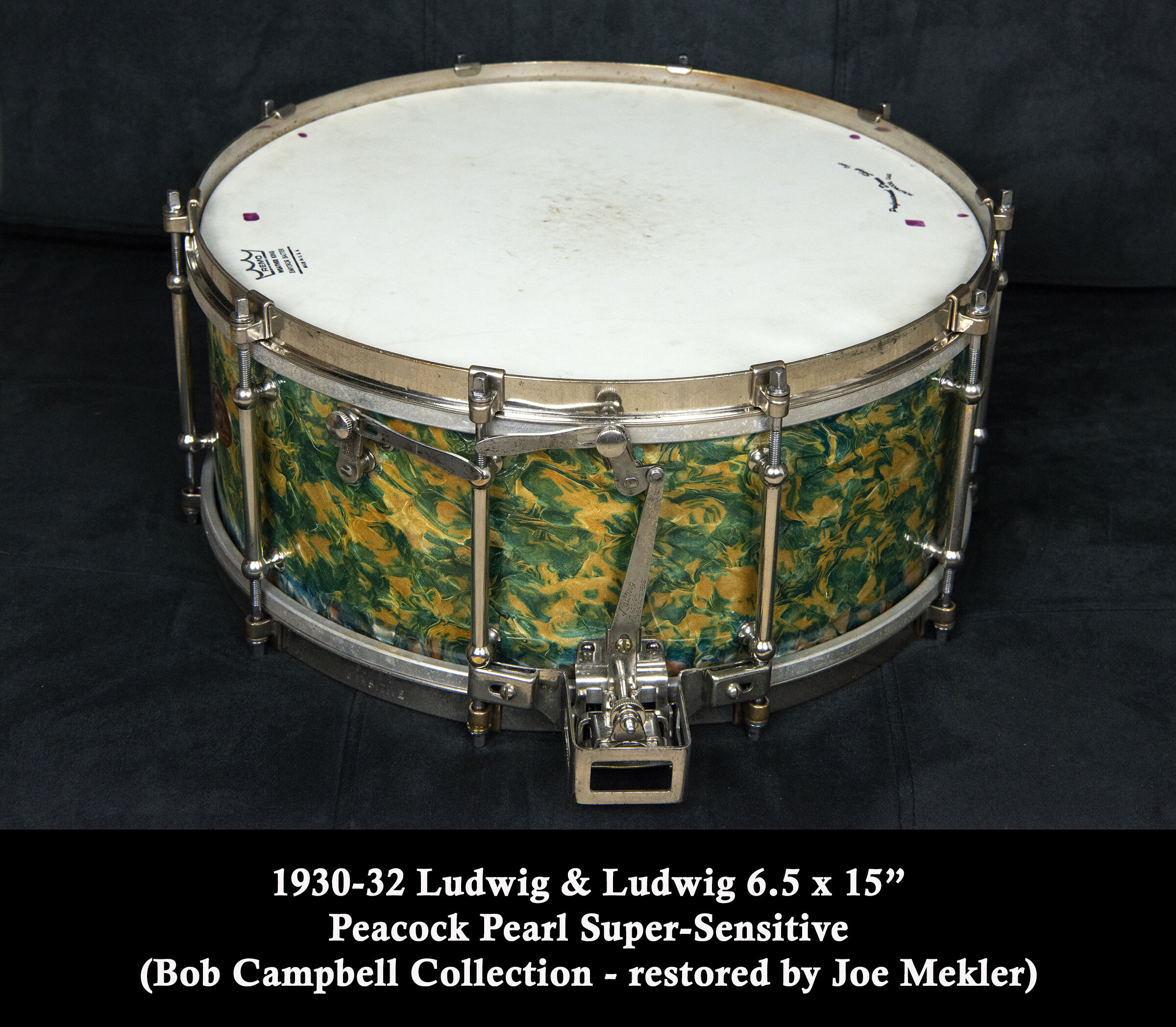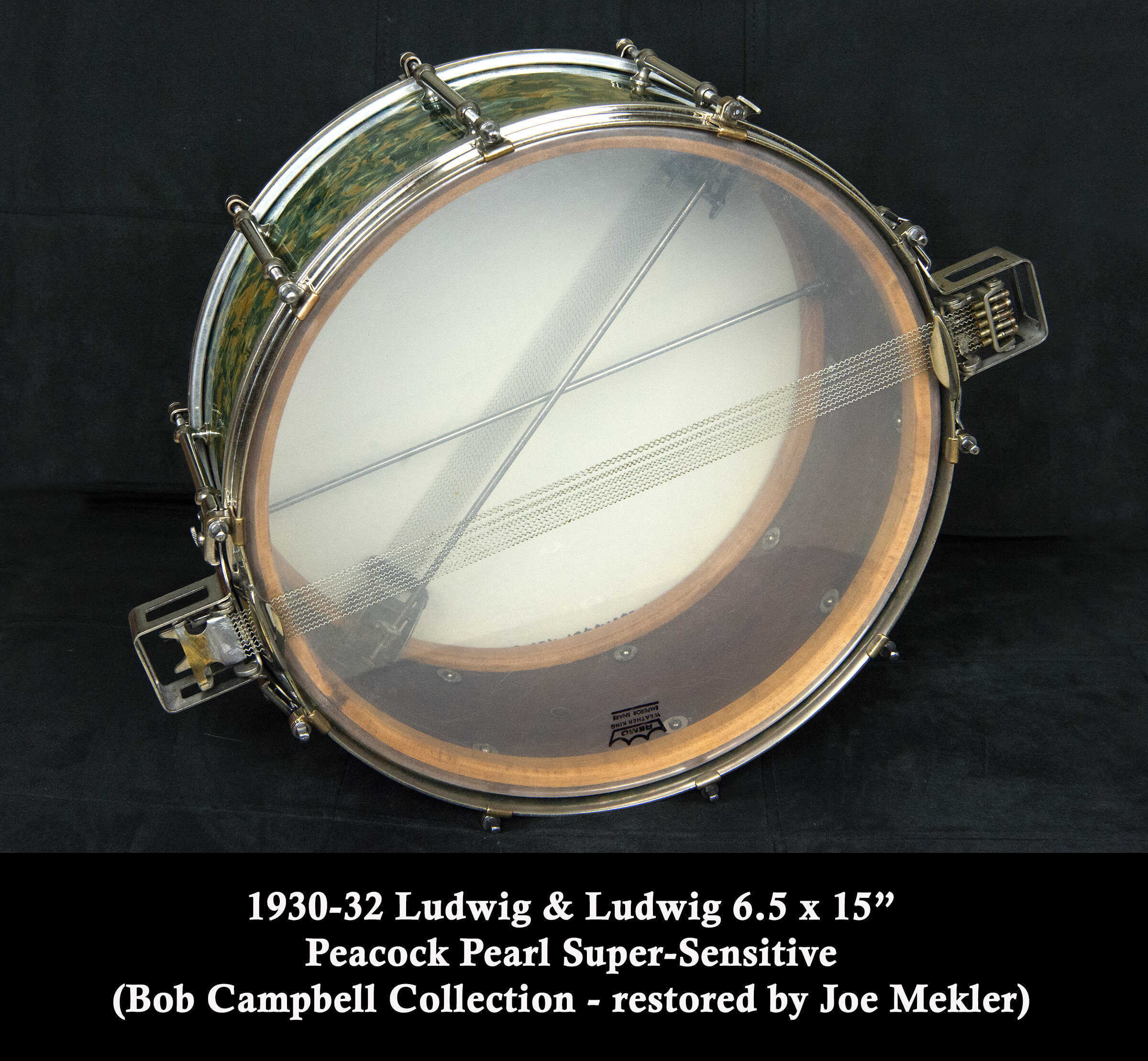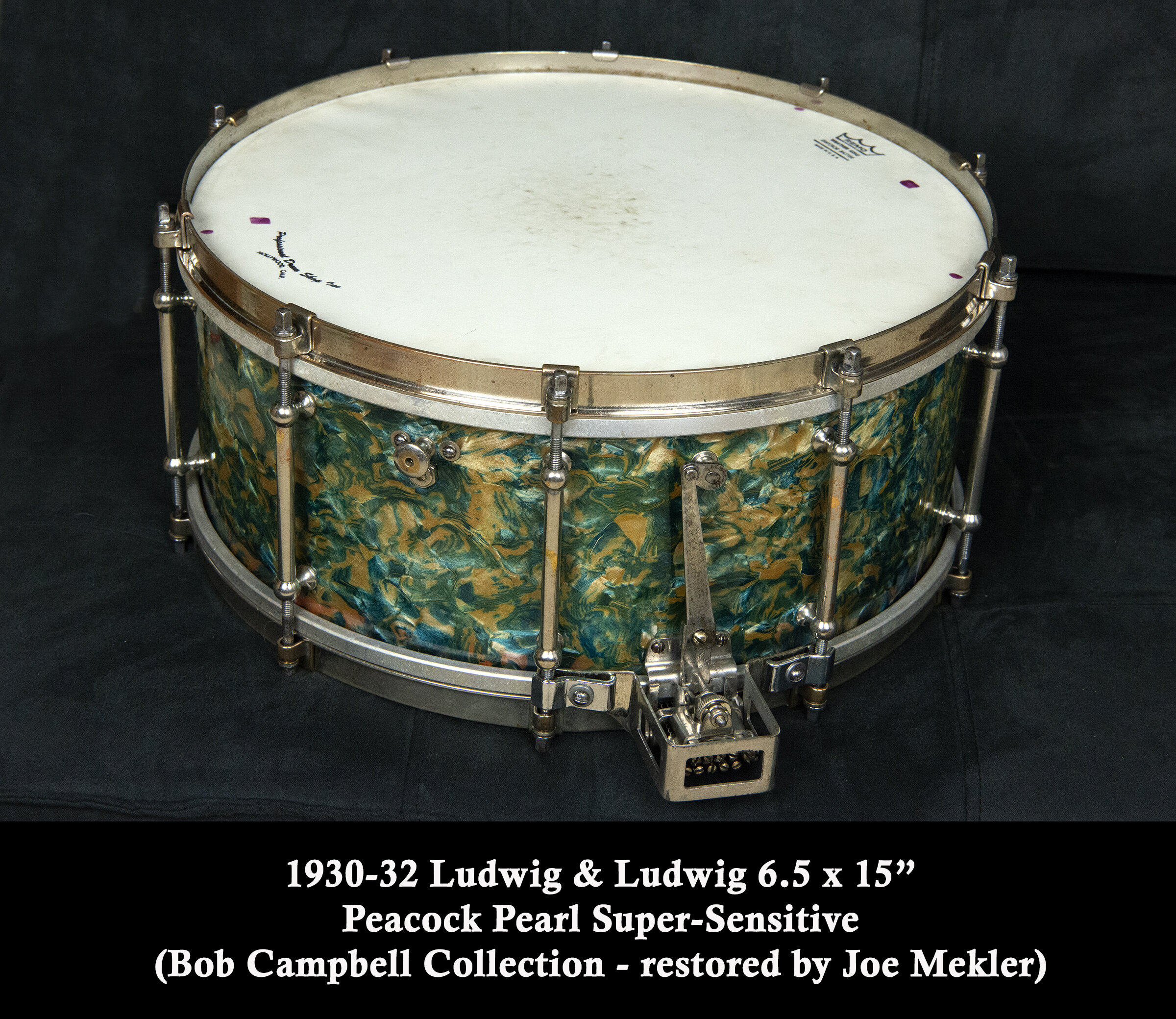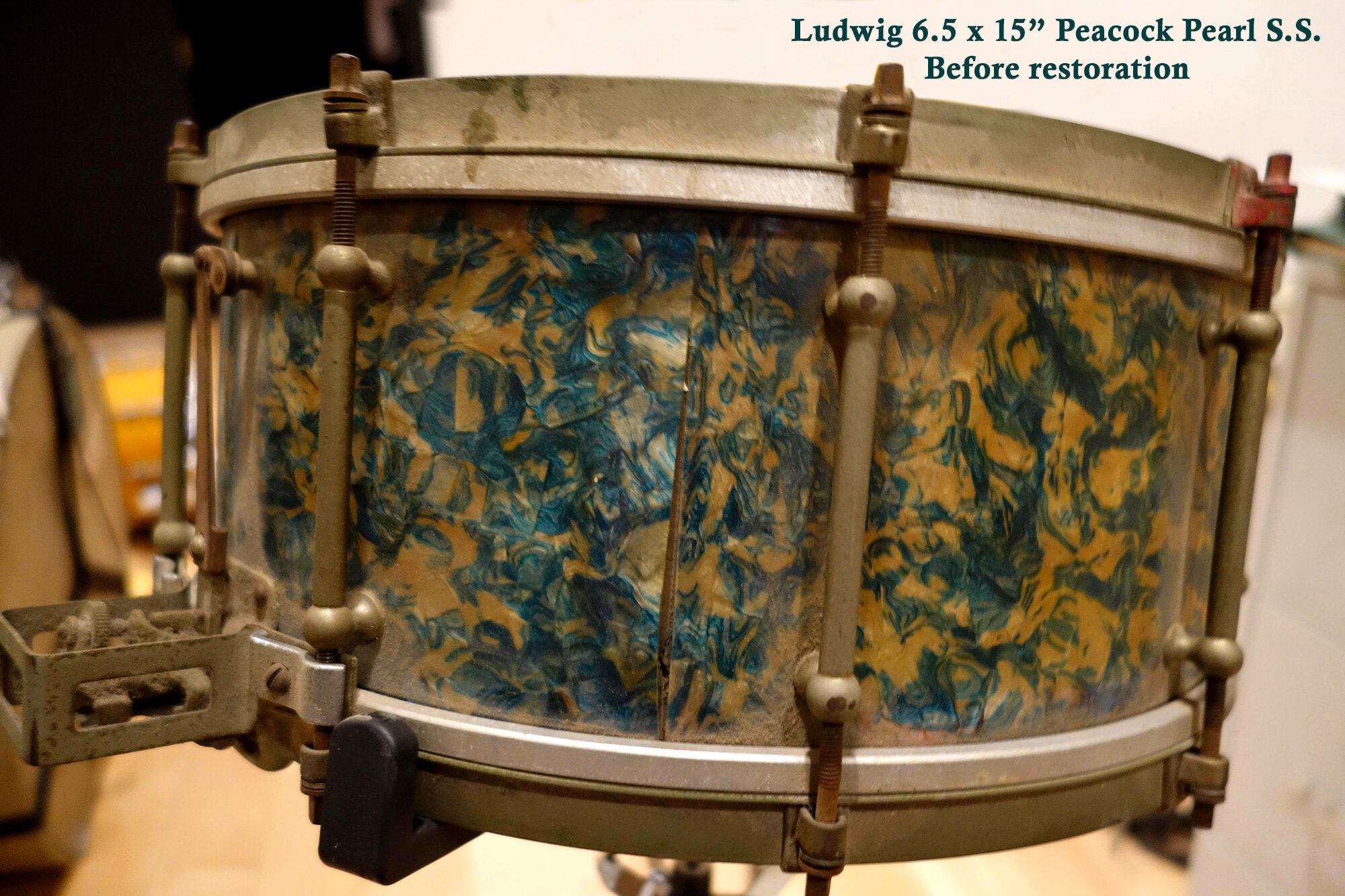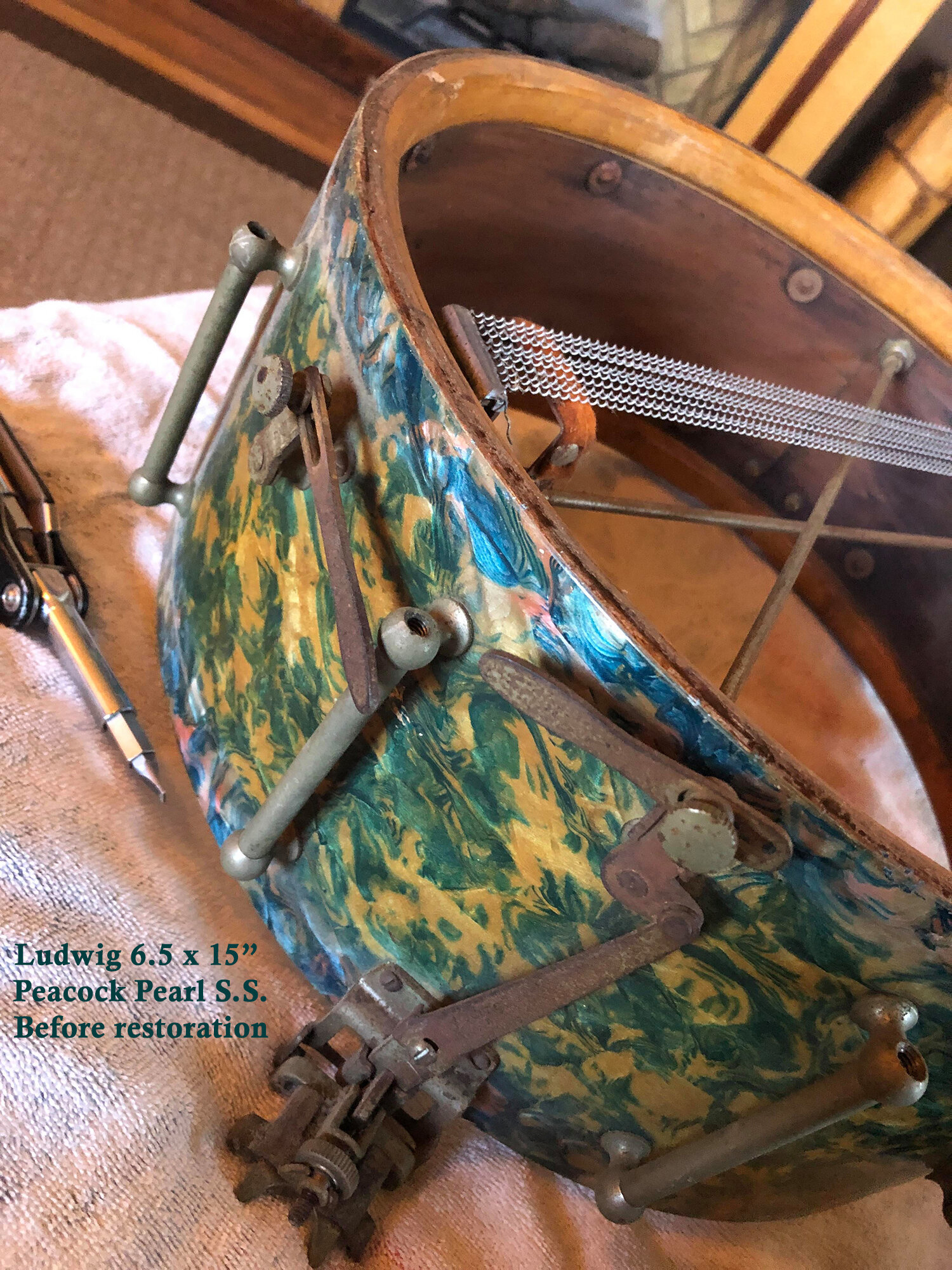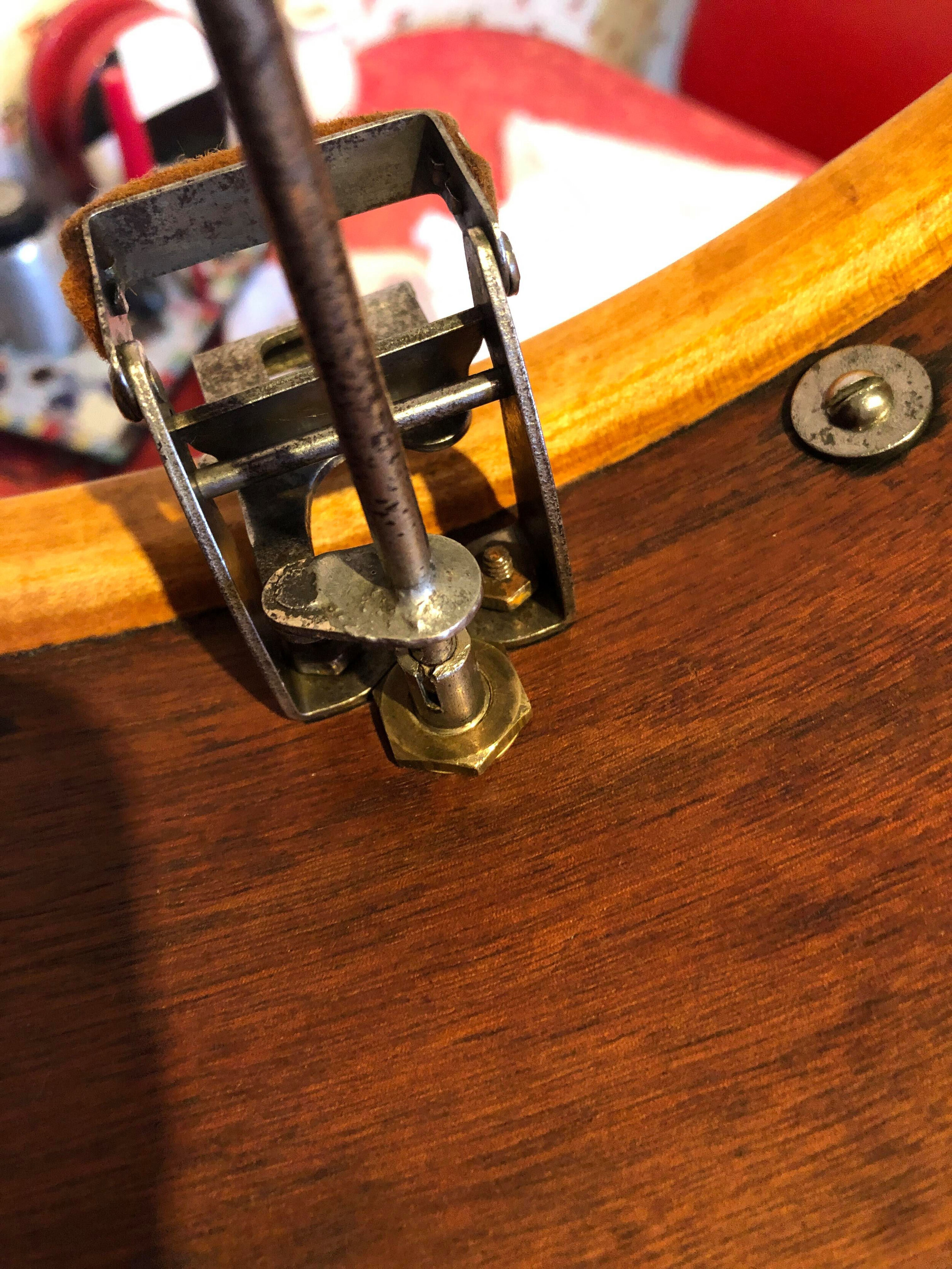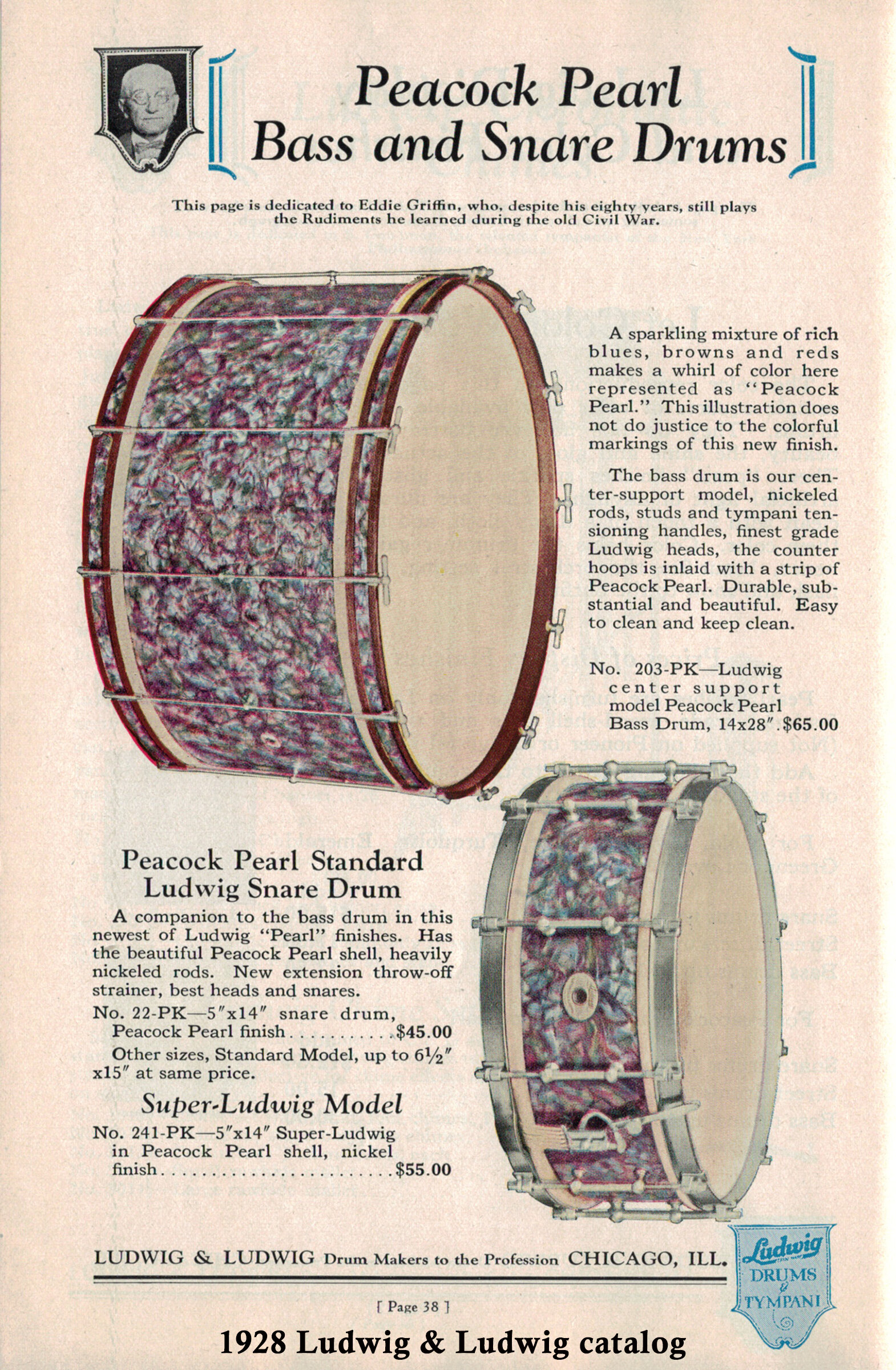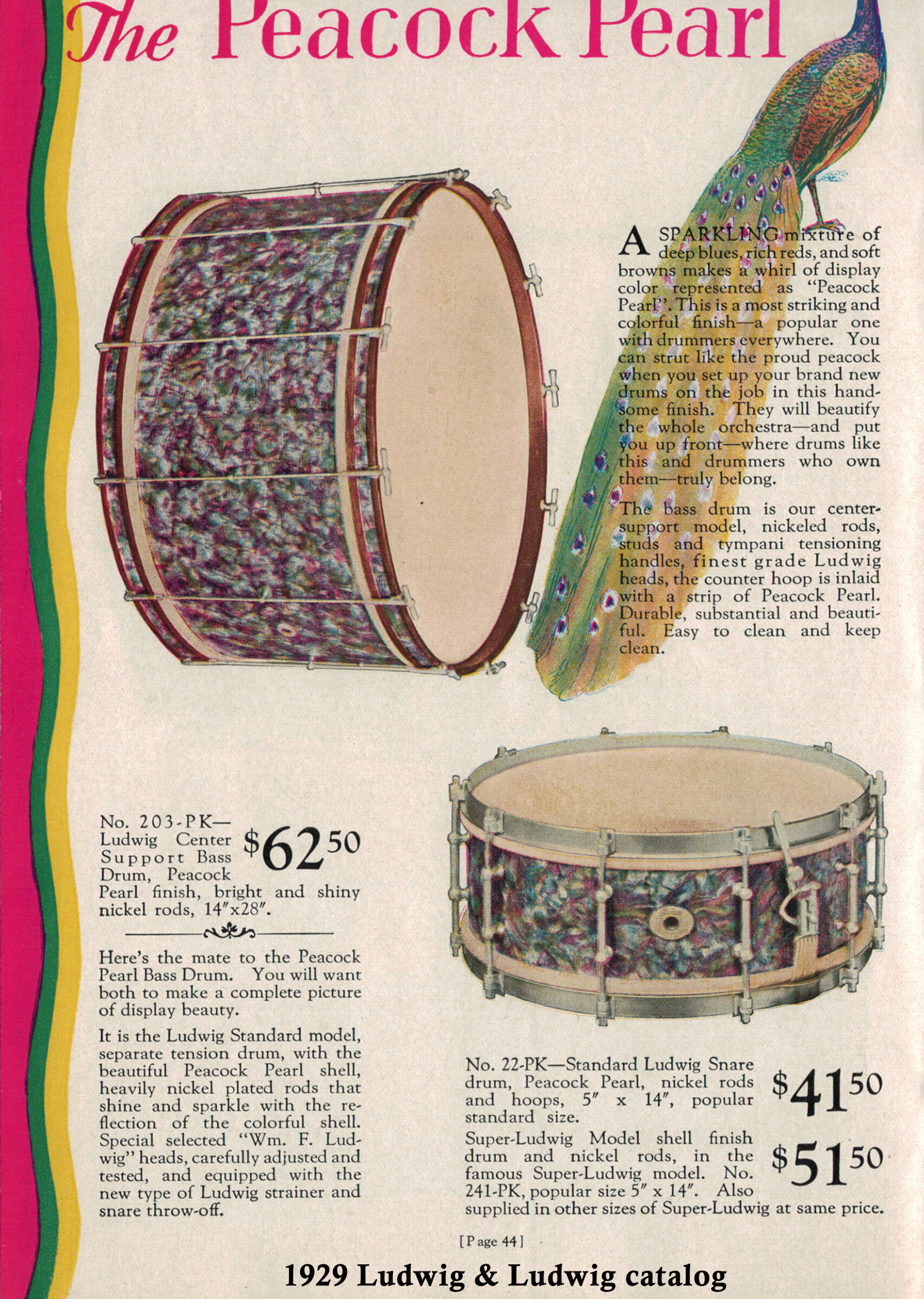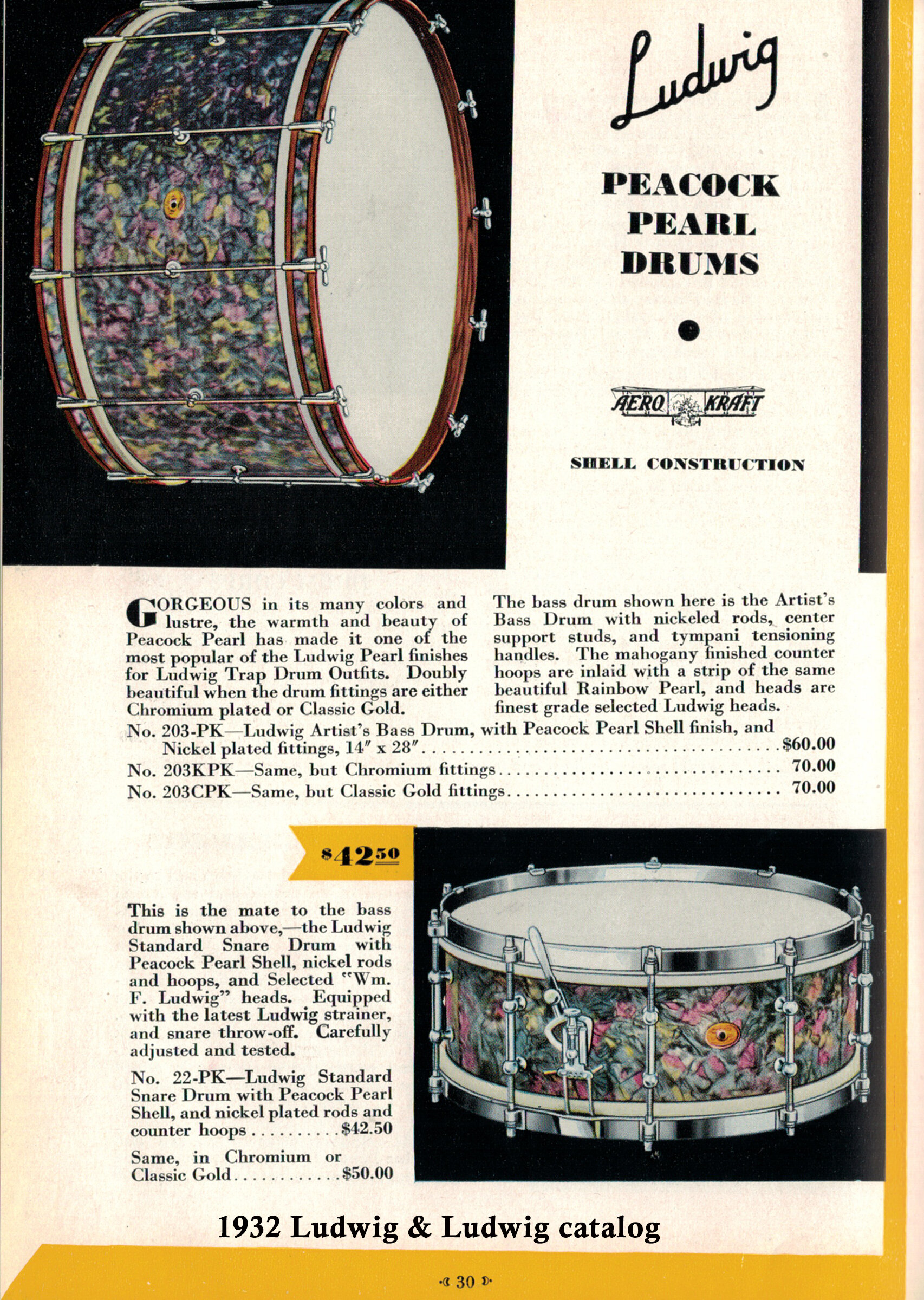Ludwig & Ludwig introduced many beautiful pearl wraps from the late 1920’s into the early 1930’s. Of these, the Peacock Pearl seems to be one of the most controversial; you either love it or hate it. Personally, I’m quite fond of these rare drums and the blend of colors that are found within. Over time, these drums have faded due to interaction with sunlight, so no two Peacock Pearl drums are exactly the same. Mark Cooper (Cooper’s Vintage Drums) noted that, “due to the translucent nature of the pearl finish, it can appear different depending on what type of wood is underneath. The wrap may appear darker over Mahogany and lighter over maple.” Peacock Pearl was produced by Ludwig from 1928-1932.
It is believed that there were two versions of the Peacock Pearl. The early version circa 1928-30 (Peacock I) had predominantly purple and blue hues which faded to a mix of orange, red and purple in many current examples. The later version (Peacock Pearl II) made from approximately 1930-32 contained more blues and greens which turned into blue, yellow and/or white with years of light exposure. Chris Ardoin’s “Three on the Floor” site features nice examples and descriptions of the Peacock I and II wraps: http://www.threeonthefloor.com/blog/1920s-1930s-ludwig-peacock-type-i-ii-finishes/ . I have the 1928, 1929, 1930, and 1932 Ludwig catalogs in my collection. The colors of the Peacock Pearl appear identical in the 1928 and 1929 catalogs, similar to the description of Peacock Pearl I. In the 1930 catalog, the Peacock Pearl color appears to have more greens and blues (Peacock Pearl II?). In the 1932 catalog, Peacock Pearl appears somewhat different than the previous depictions, with primarily blue/dark blue with greens and purples much less dominant. Were there perhaps 3 Peacock Pearl’s or was this just poor color matching by the artist and/or printer?
I now own several Ludwig Peacock Pearl snares, but all are 5 x 14”. In late 2020, I found out that Paul “Jamo” Jamieson was thinking of retiring and paring down his drum collection. Jamo is well known for his many contributions to the music industry as a drum tech and cartage/rental businessman. He has worked with some of the biggest names in the music business and accumulated some amazing drums along the way. In one of our many engaging conversations, Jamo mentioned that he had some cool vintage drums that I might be interested in. One of these was a 6.5 x 15” (yes, 15”!) Ludwig Super-Sensitive in Peacock Pearl.
The Super-Sensitive mechanism, with snare wires underneath both top and bottom heads, was introduced in 1929. The dominant blues in the finish (much less faded under the hoop) suggested that this was a Peacock II circa 1930-32. “Super-Sensitive” was stamped into the bottom hoop rather than engraved indicating it was made after 1929. The shell was mahogany with had maple reinforcing hoops. I could not find any mention of the shell construction for the Peacock Pearl snare drums in my catalogs. I asked Mike Curotto about the shell material, and he said, “I consulted Bill Wanser and he didn't have any definitive date-line, but he did say that he has seen more maple shells in the 1930’s and more mahogany shells in the 1920’s. Given that your S.S. is 1929-on, anything goes.”
This drum had been stored in Jamo’s warehouse and left untouched for years. As such, the hardware had some rust, grime/dust and the wrap’s seam was lifting. The Peacock Pearl was indeed faded/yellowed but in otherwise good condition. I was quite excited to find such a rare drum and add it to my collection. I know of no other 6.5 x 15” Peacock Super-Sensitive in existence – if any of you do, please contact me! This was an uber-rare drum worth salvaging.
Joe Mekler (“Joey Boom”) had previously done an outstanding WFL Paramount snare restoration for me. I asked if he would take on the project. I sent Joe some pics and he said, “Looks like a barn fresh forgotten beauty!” Joe immediately and enthusiastically agreed to perform the restoration.
The drum went directly to Joe, who gave me a quick survey of the restoration work needed: “It’s going to require a complete tear-down and all aspects restored. It seems to have some minor nicotine and black staining plus grime, so it will be a layered process of cleaning. The Super-Sensitive snare system will require minute detailed cleaning as well. I am happy to have it here and am honored to bring it back to where it should be. I appreciate the opportunity.”
Here is a short play-by-play of the updates from Joe:
“After checking with the experts, your drum is all factory correct. No shenanigans. Tomorrow, I will finish minor crack and bubble work followed by gluing and heat treatment. Full grime removal; clean and polish. Then, each rod and all the metal bits will be cleaned and polished. It’s intricate and practically jewelers-type minute work. The interior will need a lot of sanding and potential bleaching to get rid of the black stained areas. There you have it, sir. . . That’s the itinerary.”
· “Checking in with today’s progress: 1) Tube lugs done; 2) Rods and interior bits completely rust-free; 2nd round of gel/wire brush and scrubbed; 3) Peacock finish serious wet sand; 4) Cat bonding with shell; 5) Tonight, interior shell sand; and 6) other metal bits buff wheel polish. When done, it’s gonna be a celebrity!”
· “The hardware came out well. Each rod got Dremel wire brushed - all sides and threads, then mother’s and rouge hard/soft buff wheel and hand towel finished. Every screw head, washer and clip were Dremel wire brushed (some were wet sanded), then wheel buffed twice. Some were more corroded than others and so were hand buffed. Tomorrow, the throw arms will be waxed and buffed again. I will do the hoops tomorrow as well.”
· “Buff polish next to push ‘em over the edge to brilliance. I carefully sanded the shell and steel wooled it down. When it’s oiled, it will be gorgeous. I’m going the extra mile here. I want this drum to be shocking when seen and, of course, heard.”
· “Last inspection to be sure everything held, then final buff polish and full assembly. Finally, tweak, adjust, play, tune, and check mechanics. I am really shooting for completion this week.”
· “I just played it for a 1/2 hour. Oh man . . . It’s a real beauty and performs beautifully. It plays quite well with bottom snares at low or high tuning with loose or tight snare tensions. Then, add the top wires and it dries out, and is totally Scotch style crispy. Both mechanisms operated smoothly and held position. Pics coming. Here is a video of the test run: https://www.youtube.com/watch?v=ltMlUAxg2s8 ”
· (sends completed pics of the restoration; I was truly blown away) – “As I like to say – Boom! I am forever grateful for this opportunity to have it live and adored as it should. Your drum told me it’s story and guided me along the process.”
So needless to say, the drum came out fabulously well. I do indeed highly commend and thank Joe for his attention to detail and ability to bring this drum back to its former glory (other than the fading which is not reversible). I sent pics of the fully restored drum to Jamo. He was astounded that this crusty old beast could be resurrected into a stunning beauty. He kindly said, “I’m really glad that you got this drum and will give it the love that it deserves.”
Special thanks to:
Joe Mekler for his impeccable restoration work,
Mark Cooper, Mike Curotto, and Bill Wanser, for their insights on this drum and assistance with the article, and Jamo Jamieson for allowing me to be the next custodian of this amazing drum.


